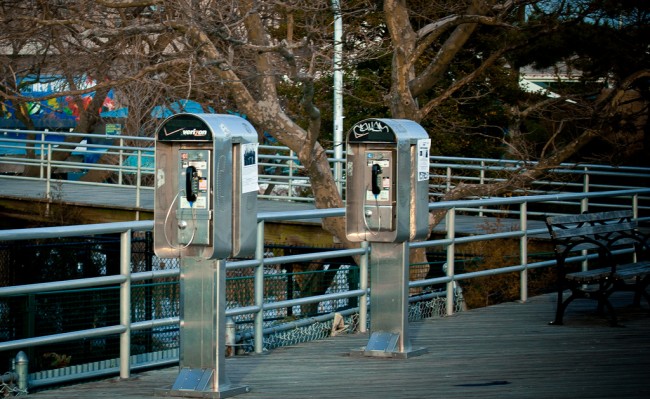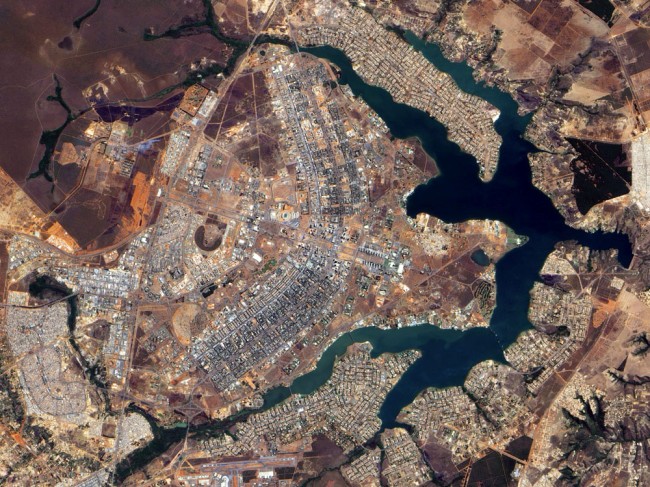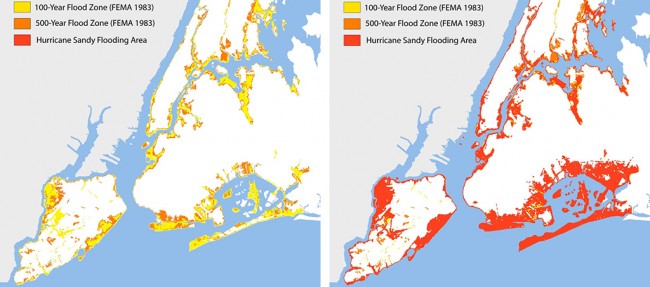
We are celebrating 15 years — and counting — of stories that are deeply researched and deeply felt, that build a historical record of what the city has been.
We are celebrating 15 years — and counting — of stories that are deeply researched and deeply felt, that build a historical record of what the city has been.

Coney Island Pay Phones | photo by Flickr user pauldc
RE-OWN THE PAYPHONE
On Monday, in an attempt to modernize the city’s payphone infrastructure, Mayor Bloomberg, Rahul N. Merchant, Commissioner of the Department of Information Technology and Telecommunications, and Rachel Haot, Chief Digital Officer, launched a new initiative on Tuesday, the Reinvent the Phone design challenge. Despite the rise of mobile phones, the availability of payphones, according to a Bloomberg administration statement, “remains critical in times of emergency, as seen by an increase in their usage after Hurricane Sandy.” Thus, the City is calling upon designers and techies to “Re-Own the Phone” and create innovative, design-driven concepts that will not only “shape the future of communications” but also “enhance the vitality of our public spaces.” Prototype applications are due February 18, 2013; 15 semi-finalists will be chosen to demonstrate their ideas on Reinvent Payphones Demo Day on March 5, 2013.
HUDSON YARDS BREAKS GROUND
Tuesday’s groundbreaking ceremony for a group of towers above the MTA rail yard west of Penn Station begins the transformation of the largest tract of undeveloped plot of land in Manhattan into one of the biggest private developments — the towers will total 13 million square feet once complete — in the city’s history. The first building, designed by Kohn Pederson Fox (KPF), will rise 47 stories at the corner of 30th Street and 10th Avenue. Mayor Bloomberg called the project a “testament to our city’s economic strength.” Head over to the Gothamist for an image gallery.
UNSTACKING MY LIBRARY
The New York Public Library (NYPL) is planning a $300 million renovation, consolidating two nearby branches into its historic building on 42nd Street and selling those lucrative Midtown properties to fund an interior overhaul. The original, seven-story book stacks underneath the famous central reading room will be demolished and replaced with an addition by Norman Foster. A recent in-depth piece by Paul Goldberger in Vanity Fair includes interviews with Foster and Library President Tony Marx. This week, Ada Louise Huxtable, writing in The Wall Street Journal, remains unconvinced by the NYPL’s plans, arguing in her typically august and even-keeled manner that “you don’t update a masterpiece.” Her take is worth reading in full, for it is not based on a nostalgic resistance to change, but rather rooted in a careful and clear-eyed analysis of the NYPL’s architectural and scholarly assets, and its institutional responsibility not to the present, but the future.

Brasilia, Brazil | photo via NASA Earth Observatory
CITIES FROM SPACE
With radial roads and star shaped grids, planned cities design every element with purpose. Wired‘s collection of photos of cities from space provide a stunning vantage point to look at the beauty, and shortfalls, possible when designing a metropolis in one swoop including Palmanova, Italy; Canberra, Australia; and Brasília, Brazil, the latter made all the more poignant by the death this week of its visionary master planner, Oscar Niemeyer, just ten days shy of his 105th birthday.
FREEMAN IS THE NEW REAL
Neil Freeman is an artist-urban planner hybrid who is no more one part than the other. Eric Jaffe of The Atlantic Cities celebrates Freeman’s work in a recent profile piece, highlighting his nuanced vision and range of creative projects (we’ve featured quite a few of them in the past). Freeman credits his style to a fusion of distinct passions: “Anyone who has more than one thing they’re passionate about — and there are a lot of people out there like that — you end up finding ways to connect them.” While a professional planner nowadays, he continues to create artwork that recasts our understanding of the built environment and urban informatics, which you can explore on his website, Fake is the New Real.

FEMA’s 100-year flood map (left) compared to the flooding caused by Sandy (right) | via New York Mayor’s Office
SANDY
On Thursday morning, at an event hosted by the Regional Plan Association and the New York League of Conservation Voters, Mayor Bloomberg began to outline plans for creating a more resilient post-Sandy city. In his call “to re-examine all of our major infrastructure in light of Sandy – how we can adapt and modernize it, in order to protect it,” the Mayor added the storm to a sobering list of tragic New York incidents that were met with “inspired vision and impressive resolve,” including the Great Fire of 1835 (which led to the construction of the city’s aqueduct system), the Great Blizzard of 1888 (which catalyzed the subway system as well as a move towards buried power lines), the Triangle Shirtwaist Fire of 1911 (which inspired new workplace protection and fire safety measures), and the 9/11 attacks (which brought on what he called “the largest counterterrorism operation of any city in the world”).
Mayor Bloomberg reviewed a number of strategies that are being implemented, such as strengthening building code standards for flood and storm protection, re-evaluating and updating flood maps and evacuation zones, relaxing height restrictions in zoning regulations to allow for houses to be elevated out of the flood plain, and significantly improving the city’s infrastructure (transit, power, gas, communications, and medical care). The Mayor also took certain options off the table. Though many have questioned the prudence of rebuilding in the hardest-hit areas, the Mayor stated, “We are not going to abandon the waterfront.” He noted that “we can’t just rebuild what was there and hope for the best.” And while protective interventions such as berms, dunes, jetties, and levees are being considered, the Mayor again dismissed the viability of constructing a large sea wall. Moving forward, Deputy Mayors Cas Holloway and Linda Gibbs have been charged with reviewing the City’s response to Sandy and developing recommendations for improved resource deployment and service provisions throughout all stages of disasters. Their report is scheduled for completion by the end of February. Seth Pinsky, President of the Economic Development Corporation (EDC), will be in charge of recovery plans for the areas hit hardest by the storm as well as “a specific and comprehensive action plan to prepare our city for the climate risks we face.” Throughout the speech, Mayor Bloomberg reminded the audience that these efforts are not simply to prepare for the next Sandy: “We don’t know whether the next emergency will be a storm, a drought, a tornado or a blizzard, but we do know that we have to be better prepared for all of them.”
Of course, all of these plans require funding. After Mayor Bloomberg and Governor Cuomo visited Washington to petition at the federal level for a sufficient aid package, President Obama, at a crucial budgeting moment, announced plans to approach Congress for approximately $50 billion in funds (far short of the combined $82 billion requested by New Jersey, New York and Connecticut). Meanwhile, FEMA has begun to release funds for New York City recovery. And some are contemplating creative funding mechanisms, such as New York City Comptroller John Liu, who suggests the city’s pension funds might invest some of it’s $128 billion in post-storm housing.
EVENTS and TO DOs

via No Longer Empty
HOW MUCH DO I OWE YOU?
No Longer Empty, the nomadic cultural institution dedicated to bringing contemporary art to underutilized spaces throughout New York City, has a new show opening in Long Island City. Last winter, we profiled No Longer Empty’s South Bronx exhibition, which played on themes of class loyalties, reversals of fortune, and abandonment in its inhabiting of a grand and disused retirement home. The institution’s 14th show, How Much Do I Owe You?, opens next week, riffing off the bank environs to explore “new iterations of currency, value and exchange at this time of financial flux, growing debt and job insecurity” through the work of 26 artists from 15 countries. The exhibition will be open from December 12th, 2012, to March 13, 2013.
ON THE GRID
Tonight, OUTLET Fine Art hosts an opening reception for ON THE GRID, an exhibit “inspired by and created in response to the unique metropolitan geography of New York City.” The artists utilize a variety of mediums to express and explore the dynamic relationship between the built environment and the art forms it invokes, such as street art and performance theater. ON THE GRID features the work of A City of Children, Jilly Ballistic, El Sol 25, Jason Eppink, John Redmann, Enrico Miguel Thomas, Matthew Silver and Jowy Romano. The reception begins at 7:30 pm.
THIS IS YOUR HOME
Last year, the Citizens Housing Planning Council (CHPC) commissioned playwright Adam Thorburn to create an original play based on primary source documents from the CHPC’s archives about the landmark struggle to desegregate Stuyvesant Town in the 1940s and ’50s. The play, Stuyvesant Town: This is Your Home, will open on Monday at the Pershing Square Signature Center. The event starts at 6:30 pm with a wine and cheese reception, followed by a panel discussion that will pull the issues of housing discrimination, segregation, and enforced desegregation into the present. Tickets are available here.
CLEAN NYC
Airbnb, Zipcar, and Weeels are among the growing number of companies pioneering a new model of sustainability through resource optimization and collaborative consumption. As part of their Clean Energy Connections series, SolarOne and NYC ACRE are holding a panel discussion on December 11th from 7pm to 9pm, to explore this emerging strategy. Visit their website to purchase tickets or watch the live stream online starting at 7:05pm. The event is collaborative, so tweet questions in to @CleanECNYC with hashtag #CleanNRGx.
The Roundup keeps you up to date with topics we’ve featured and other things we think are worth knowing about.
The views expressed here are those of the authors only and do not reflect the position of The Architectural League of New York.